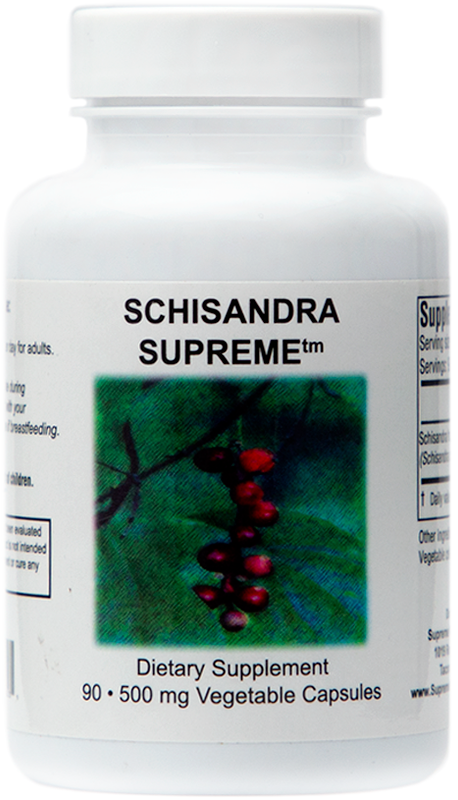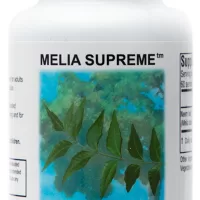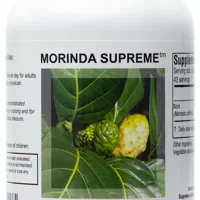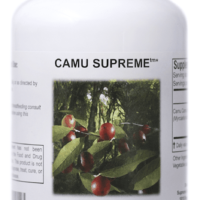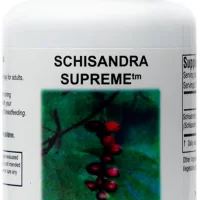Description
Schisandra is a berry originating in Eastern Asia, which has long been used in Chinese Medicine. Schisandra has been shown to increase liver function by increasing enzymatic activity, which in turn increases glutathione production (1, 2). Clinical trials in China by Liu KT in Studies on Fructus Schizandre Cinensis have shown that Schisandra berries can help those with chronic viral hepatitis (3). One mechanism of hepatitis alleviation is lowering levels of serum glutamic pyruvic transaminase (SGPT), a marker of hepatitis and many other liver disorders (4). It also may lower SGOT (5). Schisandra is thought to help regrow hepatic cells damaged by alcohol ingestion (6, 7, 8, 9, 10). The active parts of Schisandra currently identified as helping liver function are: schizandrin, deoxyschizandrin, gomisins, and pregomisin (11).
Animal studies have shown that Schisandra can increase physical stamina and energy levels (12). It can also quicken reflexes and increase focus; in addition to protecting against things such as heat shock, frostbite, heavy metal intoxication, radiation, high altitude problems and certain types of inflammation (13). Schisandra may also be a useful adjunct to chemotherapy due to both its liver protective properties (especially phase 1 detoxification) as well as its immune modulating properties (5). It can potentially help people handle the toxicity of certain pharmaceuticals they take. Heart contractility has also been shown to increase, without a change in blood pressure (14). In addition to increasing physical stamina, Schisandra is thought to increase mental stamina and focus as well as visual and hearing acuity (15). Schisandra is also known to have phytoadaptagenic properties (similar to ginseng) and to assist the endocrine, immune, and sympathetic nervous systems (16). It may help with cardiovascular and GI problems, increase bile secretion, and even help in the prevention of atherosclerosis (17, 18). It is also reported that Schisandra has an aphrodisiac affect on both men and women (by increasing men’s staying power and stimulating sensitivity in the females’ genitals) (19).
Schisandra is known to having some antimicrobial functions. It is thought to be especially effective against Bacillus dysenteriae, Staphylococcus epidermidis, Staphylococcus aureus, Bacillus subtilis, Escherichia coli, Pseudomonas aeruginosa, Proteus vulgaris and HIV (20, 21, 22, 23).
In clinical practice it appears to be a very effective antimicrobial against many types of organisms (fungal, bacterial, viral, etc.). It also has been very useful in patients who have suffered from liver stress or need to possibly excrete some stored xenobiotics, chemicals, metals, and mycotoxins. There are quite a few patients who need to be on it for 3-6 months and report many positive changes from taking it. We have seen it help chronic eczema as well.
Chinese medicine typically prescribes Schisandra to treat mental illnesses such as depression, and to help against insomnia (24).
Many studies have demonstrated the anti-inflammatory properties of Schisandra (25, 26). Also taking Schisandra for 4-6 days decreased hepatic total cholesterol (TC) and triglyceride (TG) levels (by up to 50% and 52%, respectively) in hypercholesterolaemic mice (27). It also causes relaxation of smooth muscle tissue and prostate tissues and could help with benign prostate hyperplasia (28).
Contraindications:
Do not take during pregnancy, as it can increase uterine contractions (though it has been used to induce labor).
Dosage:
Our Recommended dose is one cap 3x/day.
Citations:
1. Cheng, Ni, Naiyan Ren, Hui Gao, Xingsheng Lei, Jianbin Zheng, and Wei Cao. “Antioxidant and Hepatoprotective Effects of Schisandra Chinensis Pollen Extract on CCl4-induced Acute Liver Damage in Mice.” Food and Chemical Toxicology 55 (2013): 234-40. Web.
2. Chiu, P. Y., D. H. Mak, M. K. Poon, and K. M. Ko. “In Vivo Antioxidant Action of a Lignan-Enriched Extract of Schisandra Fruit and an Anthraquinone-Containing Extract of Polygonum Root in Comparison with Schisandrin B and Emodin.” Planta Med Planta Medica 68.11 (2002): 951-56. Web.
3. Liu KT.Studies on fructus Schisandrae chinensis. Annex 12: Studies on fructus Schisandrae chinensis. Plenary lecture, World Health Organization (WHO) Seminar on the Use of Medicinal Plants in Health Care, Sept 1977, Tokyo, Japan. In: WHO Regional Office for the Western Pacific, Final Report, November 1977, Manila, 101–121
4. C. Yank-yong, S. Zeng-Bao, and L. Lian-Niang, “Studies of Fructus schizandrae. IV. Isolation and determination of the active compounds (in lowering high SGPT levels) of Schizandra chinesis Baill,” Scientia Sinica, vol. 19, no. 2, pp. 276-290, 1976.
5. Zhu, M., K.f. Lin, R.y. Yeung, and R.c. Li. “Evaluation of the Protective Effects of Schisandra Chinensis on Phase I Drug Metabolism Using a CCl4 Intoxication Model.” Journal of Ethnopharmacology 67.1 (1999): 61-68. Web.
6. Park, Hyoung Joon, Soo-Jung Lee, Yuno Song, Sun-Hee Jang, Yeoung-Gyu Ko, Suk Nam Kang, Byung Yeoup Chung, Hong-Duck Kim, Gon-Sup Kim, and Jae-Hyeon Cho. “Schisandra Chinensis Prevents Alcohol-Induced Fatty Liver Disease in Rats.” Journal of Medicinal Food 17.1 (2014): 103-10. Web.
7. Takeda, Shigefumi, Yoshio Kase, Ichiro Arai, Yasufumi Ohkura, Masayuki Hasegawa, Yuko Sekiguchi, Akemi Tatsugi, Shuji Funo, Masaki Aburada, and Eikichi Hosoya. “Effects of TJN-101, a Lignan Compound Isolated from Schisandra Fruits, on Liver Fibrosis and on Liver Regeneration after Partial Hepatectomy in Rats with Chronic Liver Injury Induced by CCl4.” Folia Pharmacologica Japonica 90.1 (1987): 51-65. Web.
8. Fan, X., Y. Jiang, Y. Wang, H. Tan, H. Zeng, Y. Wang, P. Chen, A. Qu, F. J. Gonzalez, M. Huang, and H. Bi. “Wuzhi Tablet (Schisandra Sphenanthera Extract) Protects against Acetaminophen-Induced Hepatotoxicity by Inhibition of CYP-Mediated Bioactivation and Regulation of NRF2-ARE and P53/p21 Pathways.” Drug Metabolism and Disposition 42.12 (2014): 1982-990. Web.
9. Li, Bin, Lijie Zhu, Ting Wu, Jiachen Zhang, Xinyao Jiao, Xiuying Liu, Yanqun Wang, and Xianjun Meng. “Effects of Triterpenoid From Schisandra Chinensis on Oxidative Stress in Alcohol-Induced Liver Injury in Rats.” Cell Biochemistry and Biophysics Cell Biochem Biophys 71.2 (2014): 803-11. Web.
10. Park, Hyoung Joon, Soo-Jung Lee, Yuno Song, Sun-Hee Jang, Yeoung-Gyu Ko, Suk Nam Kang, Byung Yeoup Chung, Hong-Duck Kim, Gon-Sup Kim, and Jae-Hyeon Cho. “Schisandra Chinensis Prevents Alcohol-Induced Fatty Liver Disease in Rats.” Journal of Medicinal Food 17.1 (2014): 103-10. Web.
11. Lu, Yan, and Dao-Feng Chen. “Analysis of Schisandra Chinensis and Schisandra Sphenanthera.” Journal of Chromatography A 1216.11 (2009): 1980-990. Web.
12. Li, T.S.C. 2003. The range of medicinal plants influencing mental and physical performance. In: David H. Watson (ed.) Performance functional foods. Woodhead Publishing Ltd. Cambridge, England. p. 38-60.
13. Panossian, Alexander, and Georg Wikman. “Pharmacology of Schisandra Chinensis Bail.: An Overview of Russian Research and Uses in Medicine.” Journal of Ethnopharmacology 118.2 (2008): 183-212. Web.
14. Li PC, Poon KT, Ko KM (1996). Schisandra chinensis-dependent myocardial protective action of sheng-mai-san in rats. Am. J. Chin. Med., 24: 255-262.
15. Zhukovich, E. N., S. Yu. Bokareva, L. A. Sharikova, T. F. Pribytkova, M. Yu. Semenova, and L. M. Korovina. “Biologically Active Lignans in Extract and Seeds of Schizandra Chinensis.” Pharm Chem J Pharmaceutical Chemistry Journal 41.2 (2007): 94-96. Web.
16. Doncheva, Nina D., Anita St. Mihaylova, and Damianka P. Getova. “Antinociceptive and Anti-inflammatory Effects of Rhodiola Rosea L. Extract in Rats.” Folia Medica 55.3-4 (2013): 70-75. Web.
17. MAEDA, S., TAKEDA, S., MIYAMOTO, Y., ABURADA, M. & HARADA, M. (1985). Effects of gomisin A on liver functions in hepatotoxic chemicals-treated rats. Jpn. J. Pharmacol., 38, 347–353.
18. Park, Ji Young, Hwa Kyoung Shin, You Jin Lee, Young Whan Choi, Sun Sik Bae, and Chi Dae Kim. “The Mechanism of Vasorelaxation Induced by Schisandra Chinensis Extract in Rat Thoracic Aorta.” Journal of Ethnopharmacology 121.1 (2009): 69-73. Web.
19. Kim, Hye Kyung, Yun Ok Bak, Bo Ram Choi, Chen Zhao, Hee Ju Lee, Chul Young Kim, Sung Won Lee, Ju Hong Jeon, and Jong Kwan Park. “The Role of the Lignan Constituents in the Effect of Schisandra Chinensis Fruit Extract on Penile Erection.” Phytotherapy Research Phytother. Res. 25.12 (2011): 1776-782. Web.
20. Mulyaningsih, Sri, Mahmoud Youns, Mahmoud Z. El-Readi, Mohamed L. Ashour, Endalkachew Nibret, Frank Sporer, Florian Herrmann, Jürgen Reichling, and Michael Wink. “Biological Activity of the Essential Oil of Kadsura Longipedunculata (Schisandraceae) and Its Major Components.” Journal of Pharmacy and Pharmacology 62.8 (2010): 1037-044. Web.
21. Jinghao, Zhang, Xiao Mingxia, and Ji Ping. “Experimental Study on Bacteriostasis of Scutellaria,Coptis and Schisandra on Five Kinds of Multi-drug Resistant Bacteria.” Xinjiang Medical Journal (2012): n. pag. Web.
22. Chen, Xiaoqiang, Ying Zhan, and Yuangang Zu. “Composition and Biological Activities of the Essential Oil from Schisandra Chinensis Obtained by Solvent-free Microwave Extraction.” LWT – Food Science and Technology 44.10 (2011): 2047-052. Web.
23. Li, Rong-Tao, and Et Al. Et Al. “Lancifodilactone G: A Unique Nortriterpenoid Isolated from Schisandra Lancifolia and Its Anti-HIV Activity.” ChemInform 36.42 (2005): n. pag. Web.
24. Zhang, Chenning, Xin Mao, Xu Zhao, Zhi Liu, Bing Liu, Huan Li, Kaishun Bi, and Ying Jia. “Gomisin N Isolated from Schisandra Chinensis Augments Pentobarbital-induced Sleep Behaviors through the Modification of the Serotonergic and GABAergic System.” Fitoterapia 96 (2014): 123-30. Web.
25. Qiao, Wei, Chuan Zhao, Nan Qin, Hui Yuan Zhai, and Hong Quan Duan. “Identification of Trans-tiliroside as Active Principle with Anti-hyperglycemic, Anti-hyperlipidemic and Antioxidant Effects from Potentilla Chinesis.” Journal of Ethnopharmacology 135.2 (2011): 515-21. Web.
26. Kang, Saeromi, Kyoung-Pil Lee, Soo-Jin Park, Dae-Young Noh, Jung-Min Kim, Hyung Ryong Moon, Young-Geun Lee, Young-Whan Choi, and Dong-Soon Im. “Identification of a Novel Anti-inflammatory Compound, α-cubebenoate from Schisandra Chinensis.” Journal of Ethnopharmacology 153.1 (2014): 242-49. Web.
27. Pan, Si-Yuan, Hang Dong, Xing-Ye Zhao, Chun-Jing Xiang, Hai-Yan Fang, Wang-Fun Fong, Zhi-Ling Yu, and Kam-Ming Ko. “Schisandrin B from Schisandra Chinensis Reduces Hepatic Lipid Contents in Hypercholesterolaemic Mice.” Journal of Pharmacy and Pharmacology 60.3 (2008): 399-403. Web.
28. Choo, Seol Ho, Hyun Hwan Sung, Mee Ree Chae, Su Jeong Kang, Deok Hyun Han, Jong Kwan Park, Insuk So, and Sung Won Lee. “Effects of Schisandra Chinensis Extract on the Relaxation of Isolated Human Prostate Tissue and Smooth Muscle Cell.” Journal of Ethnopharmacology 156 (2014): 271-76. Web.

